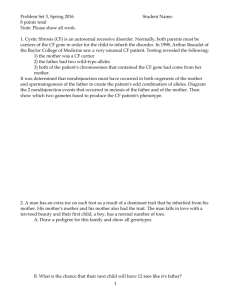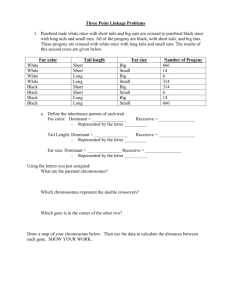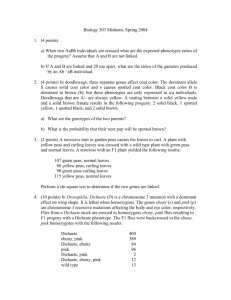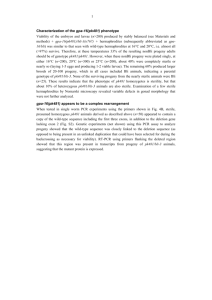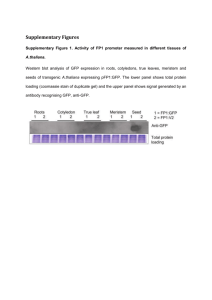Problem Set I
advertisement
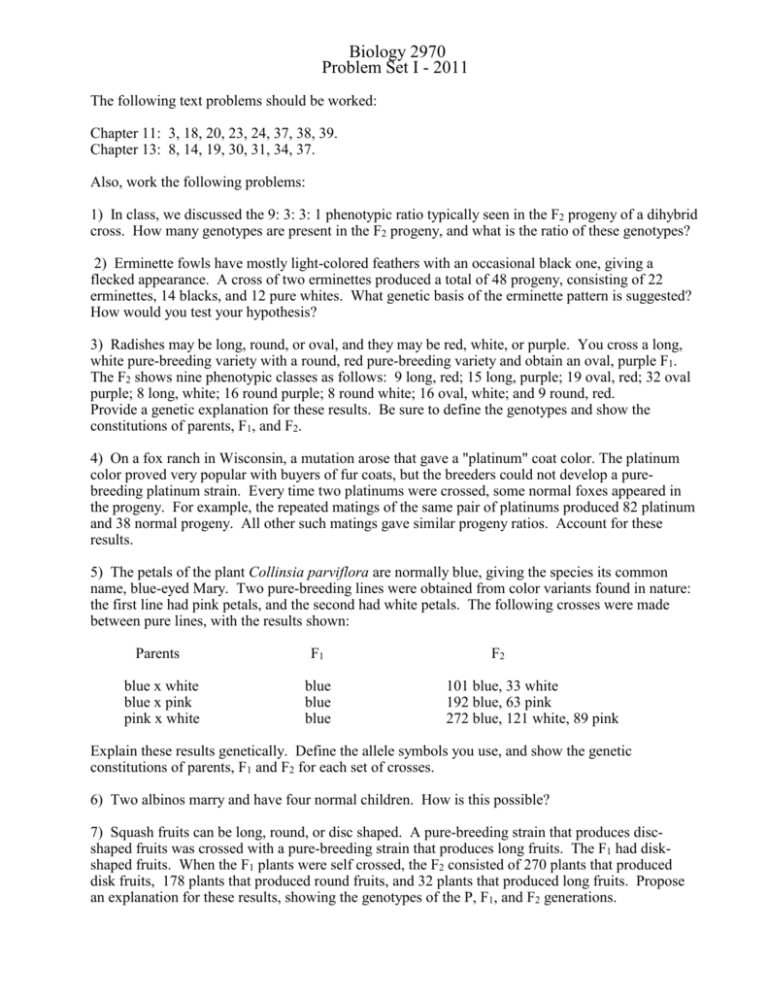
Biology 2970 Problem Set I - 2011 The following text problems should be worked: Chapter 11: 3, 18, 20, 23, 24, 37, 38, 39. Chapter 13: 8, 14, 19, 30, 31, 34, 37. Also, work the following problems: 1) In class, we discussed the 9: 3: 3: 1 phenotypic ratio typically seen in the F2 progeny of a dihybrid cross. How many genotypes are present in the F2 progeny, and what is the ratio of these genotypes? 2) Erminette fowls have mostly light-colored feathers with an occasional black one, giving a flecked appearance. A cross of two erminettes produced a total of 48 progeny, consisting of 22 erminettes, 14 blacks, and 12 pure whites. What genetic basis of the erminette pattern is suggested? How would you test your hypothesis? 3) Radishes may be long, round, or oval, and they may be red, white, or purple. You cross a long, white pure-breeding variety with a round, red pure-breeding variety and obtain an oval, purple F1. The F2 shows nine phenotypic classes as follows: 9 long, red; 15 long, purple; 19 oval, red; 32 oval purple; 8 long, white; 16 round purple; 8 round white; 16 oval, white; and 9 round, red. Provide a genetic explanation for these results. Be sure to define the genotypes and show the constitutions of parents, F1, and F2. 4) On a fox ranch in Wisconsin, a mutation arose that gave a "platinum" coat color. The platinum color proved very popular with buyers of fur coats, but the breeders could not develop a purebreeding platinum strain. Every time two platinums were crossed, some normal foxes appeared in the progeny. For example, the repeated matings of the same pair of platinums produced 82 platinum and 38 normal progeny. All other such matings gave similar progeny ratios. Account for these results. 5) The petals of the plant Collinsia parviflora are normally blue, giving the species its common name, blue-eyed Mary. Two pure-breeding lines were obtained from color variants found in nature: the first line had pink petals, and the second had white petals. The following crosses were made between pure lines, with the results shown: Parents F1 blue x white blue x pink pink x white blue blue blue F2 101 blue, 33 white 192 blue, 63 pink 272 blue, 121 white, 89 pink Explain these results genetically. Define the allele symbols you use, and show the genetic constitutions of parents, F1 and F2 for each set of crosses. 6) Two albinos marry and have four normal children. How is this possible? 7) Squash fruits can be long, round, or disc shaped. A pure-breeding strain that produces discshaped fruits was crossed with a pure-breeding strain that produces long fruits. The F1 had diskshaped fruits. When the F1 plants were self crossed, the F2 consisted of 270 plants that produced disk fruits, 178 plants that produced round fruits, and 32 plants that produced long fruits. Propose an explanation for these results, showing the genotypes of the P, F1, and F2 generations. 8) A researcher crossed two different pure-breeding white flowered lines of snapdragon plants. The F1 plants were all white flowered. When the F1 plants were self crossed, an F2 was produced that consisted of 131 white-flowered plants and 29 red-flowered plants. Deduce the inheritance of these phenotypes using clearly defined gene symbols. Give genotypes for the parents, F1, and F2. 9) In a certain species of fly, the normal eye color is red (R). Four different pure-breeding lines of this fly were obtained: two of these lines have yellow eyes (Y1 and Y2), one has brown eyes (B), and one has orange eyes (O). These four lines were crossed together in all possible combinations. For each combination, F1 flies were interbred to produce an F2. The F1's and F2's are shown within the following Table; the pure lines are given in the margins. Y1 F1 F2 Y2 F1 F2 B F1 F2 O F1 F2 Y1 all Y all Y Y2 all R 9R 7Y B all R 9R 4Y 3B O all R 9R 4O 3Y all Y all Y all R 9R 4Y 3B all R 9R 4Y 3O all B all B all R 9R 4O 3B all O all O a Using your own symbols, show genotypes for the four pure lines. b. Explain how the F1 phenotypes and the F2 ratios are produced. c. Show a biochemical pathway that explains the genetic results, indicating which gene controls which enzyme. 10) Plant breeders obtained three different pure-breeding lines of white-flowered Petunia. They performed the following crosses, which produced the progeny shown: Cross: 1 2 3 4 5 6 Parents: line 1 x line 2 line 1 x line 3 line 2 x line 3 red F1 x line 1 red F1 x line 2 red F1 x line 3 Progeny: F1 all white F1 all red F1 all white 1/4 red : 3/4 white 1/8 red: 7/8 white 1/2 red: 1/2 white Explain these results using gene symbols of your own choice. Show parental and progeny genotypes in each cross.

